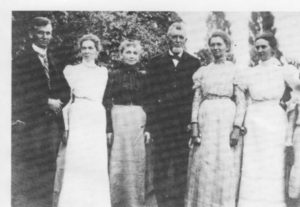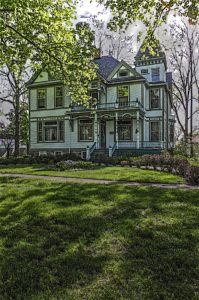Charles Palmer House

Charles Palmer Family – Circa 1900 (Left to Right) Son Harry, Daughter Grace, Wife Effie, Charles Palmer, Daughter Effie, Daughter Blanche (Daughter Bernice on right out of photo).
Charles Palmer House
240 N Main Street
Circa 1890
The founder of Imlay City, Charles Palmer, built one of its grandest houses in 1890.
The Charles Palmer House, built to replace an earlier residence, is a painted, two-story, Queen Anne residence framed and sheathed in wood. The home displays many design elements traditional to the style including asymmetrical massing and fenestration, a variety of window shapes and sizes, a complex roof-line of hipped and gabled shapes, and a rich overlay of shingled, carved, incised, turned and jig-sawed wood ornamentation. Inside the home features its original, U-shaped staircase, front and back parlors and decoratively plastered ceilings, leaded glass windows, paneled sliding doors, and several fine fireplaces. The home remains largely intact except for the addition of bathrooms and modernization of the kitchen inside, and outside in the back, the construction of an enclosed porch and attached garage.
The Charles Palmer House is one of the two finest Queen Anne houses in Imlay City. It is also significant as the home of Imlay City founder Charles Palmer, the foremost character in the community’s early history because of the associations with the key events of settlement, platting, and early economic development. The house is inspired by the work of Imlay and Walter Beech who were developing the community of Almont. Charles Palmer purchased two hundred forty acres at a point between Capac and Attica in Lapeer County, surveyed and platted the tract, and began selling home sites. In June of 1870, he started construction of the Bancroft House, a railroad hotel that opened for business on August 17, 1870; just two days after the railroad began service to the community that Palmer named Imlay City. Although his first construction burned to the ground in 1873, Palmer’s influence on the town’s development continued after his death on May 3, 1916. He established and served as president of the Charles Palmer Banking House of Imlay City, served as a village trustee, worked as a school board member for twelve years, and helped organize the local Congregational Church. In architectural terms, his former home reflects Palmer’s prominence in his community and is a landmark of the Queen Anne style in Imlay City.

